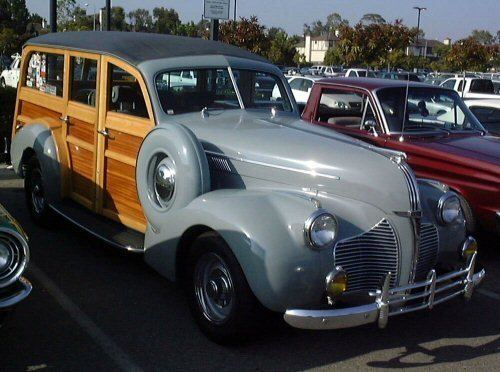 | ||
A woodie is a car body style with rear bodywork constructed of wood framework with infill wood panels. Originally, wood framework augmented the car's structure. Over time manufacturers supplanted wood construction with a variety of materials and methods evoking wood construction — including infill metal panels, metal framework, or simulated wood-grain sheet vinyl (DI-NOC) bordered with three-dimensional, simulated framework. In 2008, wood construction was evoked abstractly on the Ford Flex with a series of side and rear horizontal grooves.
Contents
1930s and 40s
As a variant of body-on-frame construction, the woodie as a utility vehicle or station wagon originated from the early practice of manufacturing the passenger compartment portion of a vehicle in hardwood. Woodies were popular in the United States and were produced as variants of sedans and convertibles as well as station wagons, from basic to luxury. They were typically manufactured as third-party conversions of regular vehicles—some by large, reputable coachbuilding firms and others by local carpenters and craftsmen for individual customers. They could be austere vehicles, with side curtains in lieu of roll-up windows (e.g., the 1932 Ford)—and sold in limited numbers (e.g., Ford sold 1654 woodie wagons). Eventually, bodies constructed entirely in steel supplanted wood construction—for reasons of strength, cost, safety, and durability.
1950s and 60s
In 1950, Plymouth discontinued their woodie station wagon. Buick's 1953 Super Estate Wagon and 1953 Roadmaster Estate Wagon were the last production American station wagons to retain real wood construction. Other marques by then were touting the advantages of "all-steel" construction to the buying public. By 1955, only Ford, Mercury, joined in 1965 by Chrysler offered a "woodie" appearance, evoking real wood with other materials including steel, plastics and DI-NOC (a vinyl product). As the appearance became popular, Ford, GM, and Chrysler offered multiple models with the woodgrain appearance until the early 1990s.
The British Motor Corporation (BMC) offered the Morris Minor Traveller (1953–71) with wood structural components and painted aluminum infill panels—the last true mass-produced woodie. Morris' subsequent Mini Traveller (1961–9) employed steel infill panels and faux wood structural members.
Simulated woodgrain
After the demise of models using actual wood construction, manufacturers continued to evoke wood construction with sheet-vinyl appliques of simulated wood grain, sometimes augmented with three-dimensional, simulated framework—and later by a simple series of indented grooves in the bodywork.
The 1966 Chevrolet Caprice in its second season, added to the four-door hardtop body style a full line of models including a vinyl-wood trimmed station wagon, the Caprice Estate. Dodge also reintroduced simulated wood the same year.
Ford marketed the Ford Pinto Squire with vinyl simulated wood trim in the early 1970s. When Chevrolet proposed a simulated woodgrain option for the Chevy Vega Kammback wagon for the 1973 model year, after a gap of four years of applying woodgrain film on the Caprice, the Vega's production schedule made smooth application of the applique difficult without wrinkles and heavy scrappage — requiring retraining by the film supplier, 3M. Subsequent rebadged variants of the Vega (marketed as "Woody"), including the Pontiac Astre Safari, Chevrolet Monza Estate and Pontiac Sunbird Safari, also offered simulated wood trim. Chevrolet offered a simulated woodie version of the Chevette in 1976, and AMC offered the Pacer wagon with optional simulated wood trim in 1977.
Ford also marketed version of their Ranchero model, a coupe utility produced between 1957 and 1979 with an open bed like a pickup truck but from a station wagon platform, with simulated woodgrain siding. In 1973, Ford produced a minivan prototype that offered a woodgrain appearance the precluded the Chrysler minivan, called the Ford Carousel but was not put into production.
Introduced in 1981, the Ford Escort and Mercury Lynx four-door wagons offered optional simulated wood trim. GM offered its full-size wagons in wood trim versions until their final year in 1996. From 1982 to 1988, Chrysler used the Town & Country name on a station wagon version of the K-based, front wheel drive LeBaron, featuring plastic woodgrain exterior trim with three dimensional simulated framework. As the station wagon declined in North America, manufacturers offered faux wood trim on SUVs and minivans (e.g., the Jeep Cherokee and Chrysler minivans). Chrysler offered simulated wood as an option for the Chrysler PT Cruiser, introduced in 2000—and aftermarket firms offered kits as well.
Japanese carmakers shied away from the appearance, although Mazda equipped the 1972-1977 Mazda Luce/RX-4 optionally, Honda briefly offered the 1980 Honda Civic station wagon, and Nissan offered the appearance on the 1983-1987 Nissan Cedric V20E SGL and Nissan Gloria V20E SGL top trim package station wagons to Japanese customers only.
In 2010, George Barris created a woodie version of the Smart Fortwo, an aftermarket firm offered a simulated wood kit for the same car, and GM displayed a prototype woodie version of the forthcoming Chevrolet Spark for the 2010 Paris Motor Show.
Introduced in 2008, the Ford Flex featured a series of side and rear horizontal grooves intended to evoke a woodie look—without either wood or simulated wood. Car Design News said the styling references "a previous era without resorting to obvious retro styling cues."
Legacy
In 1995, the U.S. Postal Service issued a 15 cent stamp commemorating the woodie wagon .
